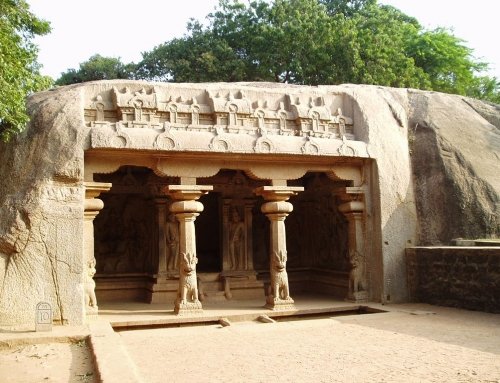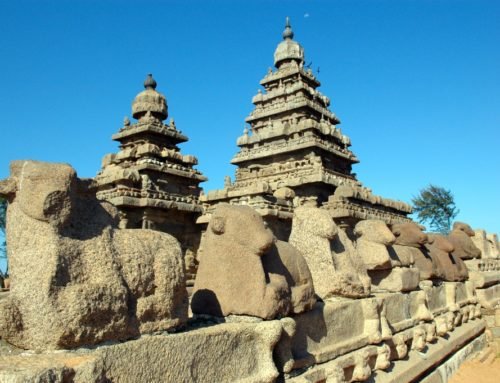Overview
- Features: Set of five monolithic rock cut temples
- Opening Times: 6:30 am to 6:00 pm, daily
- Best Time to Visit: Early weekday mornings
- Duration: 1 to 2 hours
- Travelled By: Foot
- Cost: Indian/foreigner Rs 100/250 (combined with Shore Temple)
- Address: East Raja Street, Mahabalipuram, Tamil Nadu, India
- Type: Historic site
Author Reviews[display_rating_item_results rating_form_id=”2″ rating_entry_ids=”1″ show_category_filter=”false” show_options=”true” result_type=”star_rating” preserve_max_rating=”true” show_title=”false” show_count=”false” ]
Total Rating: [display_rating_result rating_form_id=”2″ show_count=”false” show_rich_snippets=true] [accordions load=”1″] [accordion title=”User Reviews” last] [display_rating_item_results rating_form_id=”5″ show_options=”true” result_type=”star_rating” preserve_max_rating=”true” show_title=”false” show_count=”true” show_rich_snippets=true] [/accordion] [accordion title=”Add Review”][display_rating_form show_email_input=”true” show_comment_textarea=”true” show_name_input=”true” rating_form_id=”5″] [/accordion] [/accordions]
Summary
Carved from single pieces of rock, Pancha Rathas (Five Rathas) are a set of mid-7th century monolithic temples in the Dravidian style of architecture. Influenced by Buddhist architecture, each temple is dedicated to a Hindu god and named for one of the Pancha Pandavas, the five hero-brothers of the epic Mahabharata, plus their common wife, Draupadi.
Pancha Rathas (Five Rathas) Mahabalipuram
Carved from single pieces of rock, Pancha Rathas (Five Rathas) are a set of mid-7th century monolithic temples in the Dravidian style of architecture. These low-lying rock temples were influenced by Buddhist architecture as they were built in the same shape as pagodas, and greatly resemble the Buddhist vihara (monastery) and chaitya (temple hall). They imitate in granite temple structures that were originally built of wood and are among the oldest examples of their type.
[singlepic id=765 w=720 h=560 float=center]
The initial sight of these five monolithic stone shrines, set in a sandy fenced-off clearing, is dramatic, even though the structures themselves are incomplete. The ancient sculpting techniques are astonishing. Carved out of single pieces of rock from the top down, these shrines reveal perfect, precise planning. The dome-shaped shikhara (tower finial) found on some of the temples became the template for later South Indian temples, successful experiments that were further refined and enlarged.
Each temple is dedicated to a Hindu god and named for one of the Pancha Pandavas, the five hero-brothers of the epic Mahabharata, plus their common wife, Draupadi.
The shrines are meant to resemble chariots (ratha is Sanskrit for chariot), and were hidden in the sand until excavated by the British 200 years ago. Outside each ratha is a carving of an animal mount of the gods. Taken together, the layout theme of God, Pandava and animal mount is remarkable for its architectural consistency, considering everything here was cut from single chunks of rock.
Draupadi Ratha
[singlepic id=768 w=720 h=560 float=center]
The first ratha, Draupadi Ratha, on the left after you enter the gate, is dedicated to Draupadi and the goddess Durga, who represents the sacred femininity and fertility of the Indian soil. Draupadi Ratha is the smallest and simplest and is built in the form of a thatched hut. The goddess looks out at her worshippers from a carved lotus throne, while the base, now covered by sand, conceals a huge sculpted lion in front which appears to carry it, which suggests that it may be a replica of a portable shrine.
Arjuna Ratha
[singlepic id=753 w=720 h=560 float=center]
Behind the goddess shrine, a huge Nandi (bull, vehicle of Shiva) heralds the chariot of the most important Pandava, Arjuna. The domed shaped Arjuna Ratha has a small portico and carved pillar stones and is appropriately dedicated to Lord Shiva, the most important deity of the Pallavas. There are no carvings inside this temple, but many other gods, including the Vedic Indra, are depicted on the outer walls.
Bhima Ratha
[singlepic id=769 w=720 h=560 float=center]
The barrel-vaulted Bhima Ratha is the second largest, measuring 42 ft in length, 24ft in width, and 25ft in height. The pillars contain lion carvings even though the ratha as a whole is incomplete. Inside is a shrine to Vishnu.
Look around the lintels of the middle temple, Bhima Ratha, and you’ll notice faded faces that some archaeologists believe possess Caucasian features, evidence of Mahabalipuram’s extensive trade ties with ancient Rome.
Dharamraja Yudhistar’s Ratha
[singlepic id=770 w=720 h=560 float=center]
The largest of the Pancha Rathas is the domed-shaped Dharamraja Yudhistar’s Ratha. This ratha is also dedicated to Lord Shiva and is a great example of later built South Indian temples. There are many images depicted here including an interesting Ardhanarishvara (Siva-Parvati) at the rear.
Guides may tell you the carving of Pallava king Narasimhavarman on Dharmaraja Ratha resembles an Egyptian pharaoh, suggesting even earlier trade ties across the Indian Ocean. The theory is tantalising, but not terribly well substantiated.
Nakula-Sahadeva Ratha
[singlepic id=763 w=720 h=560 float=center]
To the west is the final ratha, Nakula-Sahadeva Ratha, which is dedicated to Lord Indra, the God of Rain, and has a fine sculptured elephant standing nearby. As you enter the gate, approaching from the north, you see its back first, hence its name gajaprishthakara (elephant’s backside). The life-sized image is regarded as one of the most perfectly sculptured elephants in India.
The Bhima and Nakula- Sahadeva Rathas follow the oblong plan of the Buddhist chaitya hall (temple hall) and are built to two or more storeys, a precursor to the gopuram, the elaborate entrance gateway of the Dravidian temple.
Getting to & from Pancha Rathas
The Pancha Rathas are situated on East Raja Street, 1 km (half a mile) south of Arjuna’s Penance. The best way to get here is on foot or bicycle. A self-guided walking tour of the ruins in Mahabalipuram is an excellent way to see the sites including the Pancha Rathas. Alternatively, you can speed up your tour on a bicycle which can be hired for the day in town.
A combined ticket can be bought for entrance to both Pancha Rathas and Shore Temple on the same day. Tickets are available from the ASI booth at the entrance. Approved guides can be hired at the entrance as well.







